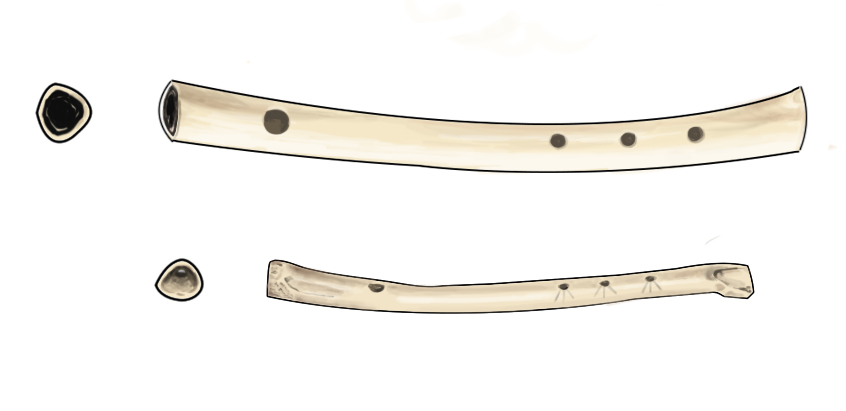Contributed by John Bergman-McCool
Recently, an unusual item was found while processing one of our adopted drawers. The Adopt-A-Drawer program lets donors support the full cataloging of artifacts housed at the Peabody. Every time a drawer is adopted we measure, weigh, photograph, and house the contents in archival storage. Beyond documentation and storage, adopted drawers represent a chance to dig deeper into the stories of the items held here at the Peabody.

The item in question was one of two bone flutes stored in the adopted drawer (figure 2). According to our catalog, they were both from Pecos Pueblo, a site in New Mexico situated in the Upper Pecos Valley east of Santa Fe. One of the flutes is labeled with a number that indicates that it was previously uncataloged and found with material from Pecos. At some point in the past, it had become separated from its provenience information.
When comparing the two flutes they are similar in most ways. They are both made from bird bones with the ends removed to make a hollow tube (sound chamber) that is open on both ends. They also share the same configuration of holes. There is a larger hole near the proximal end of the bone and three smaller holes at regular intervals near the distal end of the bone.
Where they differ is that the uncataloged flute’s sound chamber is plugged at the proximal end by a dark material with a vitreous luster. It immediately brought to mind resin, an Indigenous adhesive material that I knew of but had never seen in a decade of working as an archaeologist. The position of the plug suggested that this instrument was played like a transverse flute, which was eye opening.

I looked for information on other flutes from Pecos and fairly quickly came across an article authored by Richard W. Payne for Kiva, an archaeological journal published by the Arizona Archaeological and Historical Society. Mr. Payne was a trained medical professional with a lifelong interest in Native American flute music. You can find more information about him here and a bibliography of his writings on native flute traditions here. He is considered one of the driving forces behind the rejuvenation of the Native American (or Plains) flute, which is its own fascinating story (Conlon 2002).
Payne’s article is fairly technical, being written from the perspective of a person with years of flute playing and experience with musical theory. Neither of these subjects are in my wheelhouse. On the first read, the most interesting points concerned his visual analysis of bone flutes from Puebloan sites. Among other suppositions, he suggests that the sound window shape can determine how the instrument was played (figure 3). Round holes could serve as the embouchure of a transverse flute or as tone holes of for an end blown flute. Notched holes could be played from either end. Triangle or square holes suggest ducted flutes. (Payne 1991)

In discussing the bird bone flutes of Pecos, Payne notes that the site was occupied until the nineteenth century and that bone flutes from later contexts show evidence of European influence. Frustratingly, the claim isn’t supported with examples. Further, he mentions an article by Charles Peabody, the first director of the Peabody, wherein a flute from Pecos produced musical tones equivalent to a tabor pipe, again suggesting Western influence (Payne 1991).
The article by Charles Peabody, a talented flautist and ethnomusicologist, among other things, was written in 1917. In it, he describes asking Alfred Kidder for permission to experiment with a bone flute that was recovered while visiting Pecos during the 1916 season’s excavations. Permissions secured, those experimentations included inserting a plug of modeling clay in the proximal end of the flute. Prior to the insertion, the instrument played tones that were “excessively shrill.” After the insertion, the flute played several tones within the C sharp scale. A figure of the flute is included in Charles Peabody’s article (Peabody 1917).
When a comparison is made of the flute in Peabody’s article and the flute in question, it is clear that they are indeed one-and-the-same. The most likely scenario is that Charles Peabody acquired the flute at Pecos before it was cataloged. Eventually, it made its way back to the Peabody and was returned to the collection. By the time it was found with other materials from Pecos, all institutional knowledge of the item had been lost. Fortunately in this case, there was some record of its history.
With the story of the flute’s provenience resolved, there seems, to me, to be other questions left unanswered. These are the references to Western influence in both the musical tones and the flutes themselves suggested by Richard Payne and to a lesser degree, Charles Peabody. I’ll address those in a follow up blog.
References:
Conlon, Paula
2002 The Native American Flute: Convergence and Collaboration as Exemplified by R. Carlos Nakai. The World of Music 44(1): 61-7
Payne, Richard W.
1991 Bone Flutesof the Anasazi. Kiva 56(2): 165-177
Peabody, Charles
1917 A Prehistoric Wind-Instrument from Pecos. American Anthropologist n.s 19: 30-33
